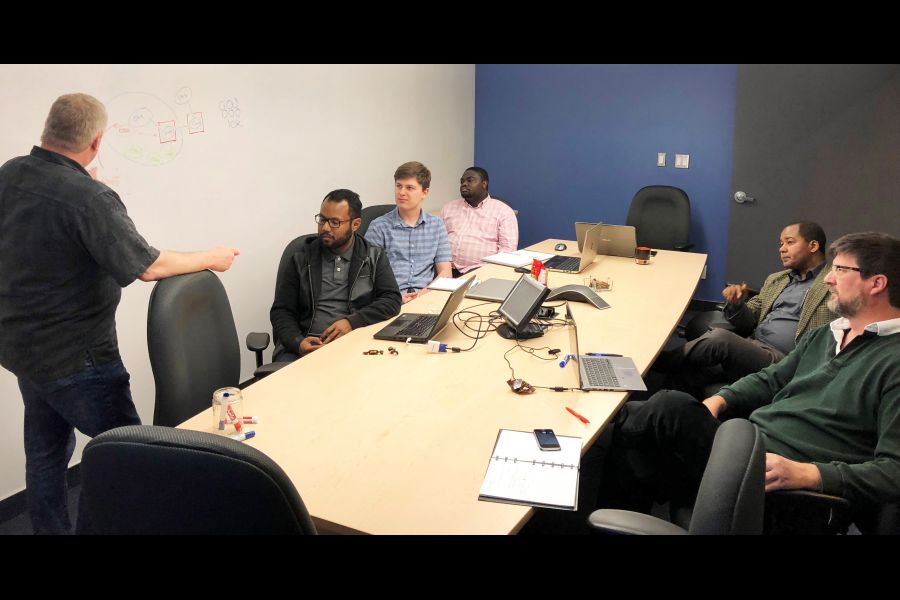When scrolling through your social media feed, it’s not uncommon to come across an ad for a restaurant in your area, a service you’ve inquired about or a store you recently made an online purchase from.
Targeted advertising is a powerful tool in business, one that Brock University researchers hope to strengthen through a new partnership with rel8ed.to, a Niagara-based data analytics company.
Brock’s Goodman School of Business is working with rel8ed.to to research how artificial intelligence can be used to create more effective ways of targeting advertisements to potential customers.
Last year, Brock Social Sciences student Valérie Plante-Brisebois and MBA graduate Pari Borah (MBA ’16) built and tested a system that scans social media postings for words and phrases that identify users’ interests and activities.
“What we’re trying to do is to take this ‘Val bot’ and make it super strong so it exceeds any method a human can come up with,” says rel8ed.to’s Managing Director Drew Fones.
The company and Brock will now be able to advance their Val-bot, named after one of the student researchers, and other text mining techniques thanks to research grants from the Ontario Centres of Excellence (OCE) and the Natural Sciences and Engineering Research Council of Canada (NSERC).
“OCE’s support is a recognition that our rigorous work and techniques have an immediate impact in the business community,” says Anteneh Ayanso, Professor of Information Systems and Director of the Goodman School’s Centre for Business Analytics. Ayanso is the lead researcher on the project, titled “Efficient Strategies and Analytics Solutions for Social Media Targeting via Text Mining.”
Currently, social media targeted advertising draws upon what Ayanso refers to as “structured data,” information that includes where potential customers live, work, their gender and some aspects of their lifestyles.
Unstructured data, on the other hand, can be found in “common-day” conversations and customer reviews that reveal people’s travel plans, their ideas, likes, dislikes, preferences and other information.
“The social media environment is contextual and dynamic,” Ayanso says. “If we combine the structured data with unstructured data, we can have a huge impact on and accuracy in the way we identify market opportunities and the right customer group for any given product or service.”
The researchers are taking this concept one step further.
The targeted advertising process is currently controlled by people who select keywords based on their knowledge of the audience they are trying to reach, a method Fones calls “highly subjective.”
He says the new, self-learning automated system being devised uses “text mining” techniques and specialized algorithms to create those keywords more quickly and precisely than human effort. Text mining analyzes data in natural, unstructured communication such as what occurs on social media.
“It will be developed as an end-to-end system wherein eventually, for any given ad content, keyword selection, demographics targeting and ad creation are all automated,” says Fones.
Results so far are encouraging.
“The first time we tested the Val-bot, the human (Plante-Brisebois) did better, debating which keywords are better and selecting them accordingly,” recalls Fones.
“The next time, a few modifications were made to the machine; the results from the human and the machine were tied. The next iteration, the Val-bot did slightly better than the human.”
The purpose of the grant is to formalize this system, advance it and take it to market.
Tek Thongpapanl, Associate Dean of the Goodman School of Business, lauds the Brock-rel8ed.to research partnership, which will employ a graduate student and undergraduate student from the University.
“The partnership’s pooled resources advance the understanding of shared challenges, making it possible to address the multifaceted nature of these challenges,” says Thongpapanl.
“More importantly, by involving our trained graduate students in these collaborations, we ensure that the country’s future generations of talent experience the shared challenges first-hand, and are involved in addressing them at the outset.”
The Brock-rel8ed.to partnership grant includes $25,000 from NSERC-Engage, $20,000 from Ontario Centres of Excellence on behalf of the Ontario Ministry of Research, Innovation and Science, and contributions from rel8ed.to in the amounts of $5,000 cash and $30,700 in-kind.










